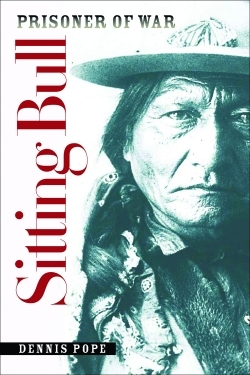Sitting Bull
Prisoner of War
On June 25, 1876, Sitting Bull, Crazy Horse, and 2,000 Lakota Sioux and Cheyenne wiped out George Custer and his Seventh Cavalry at the Battle of Little Big Horn. It was a stunning and absolutely unforgettable event in American history. But what happened next?
Dennis C. Pope’s slim and exhaustively-researched book is an account of the confusing and ultimately humiliating afterlife of Sitting Bull. As the Greek play Medea reminds us, he who the gods would destroy, they first make famous.
Sitting Bull’s fame was of rock-star quality. Newspapers and magazines like Harper’s Weekly couldn’t get enough of him. With his feather and braids, he looked the quintessential Indian. He was also, as Pope reveals, a walking bundle of contradictions who was as vain as he was brave. He totally misread the white man’s opinion of him, and it was little wonder: After five years of being relentlessly hounded from Nebraska to Canada by the US Army, he and his near-starving band of Hunkpapa Lakotas surrendered at Fort Buford in Dakota Territory. There, his people were taken prisoner and stripped of their weapons and horses, while he was taken into Bismarck where he was feted with a grand luncheon in the best hotel in town. Men stood twenty deep to get his autograph, paying as much as five dollars for the privilege. Sitting Bull thought that he was being recognized as the mighty chief of the Lakota.
He was dead wrong. The white community considered him nothing more than a curiosity. Using contemporaneous newspaper accounts and Sitting Bull’s own letters and speeches, Sitting Bull, Prisoner of War paints a sad picture of a chief and people who were made prisoners of war for two agonizing years at Fort Randall. In Sitting Bull’s eloquent and still-proud fashion, he told a Minneapolis reporter, “They gave us meat, but they took away our liberty. I would rather live in a tepee and go without meat when game is scarce than give up my privileges as a free Indian.”
The choice was not his to make. When finally released to the Lakota reservation at Standing Rock, Sitting Bull was a broken man. He spent the rest of his life selling his autograph for a dollar, and joined Buffalo Bill’s Wild West Show in 1885. In a last attempt to regain power, he trieded to sabotage a treaty in 1890. He was ordered arrested and was shot and killed in his home by Indian police.
Scholars will find this book an important adjunct to their study of the Sioux after Little Big Horn. The casual reader, as the author himself suggests, might first read Robert Utley’s classic The Lance and the Shield, which is more comprehensive.
Reviewed by
Jack Shakely
Disclosure: This article is not an endorsement, but a review. The publisher of this book provided free copies of the book to have their book reviewed by a professional reviewer. No fee was paid by the publisher for this review. Foreword Reviews only recommends books that we love. Foreword Magazine, Inc. is disclosing this in accordance with the Federal Trade Commission’s 16 CFR, Part 255.

